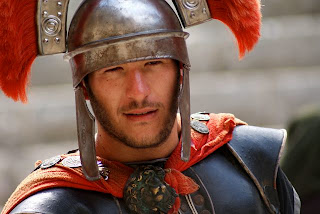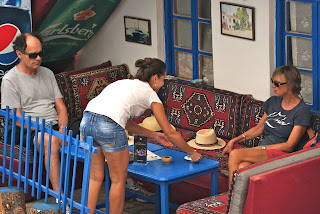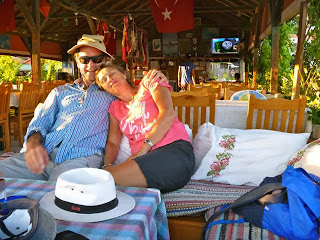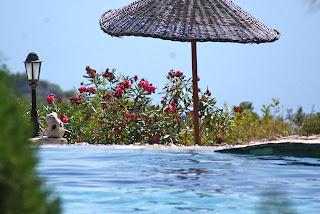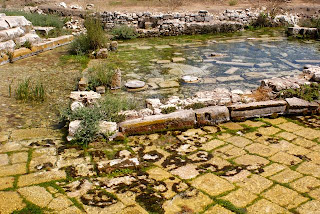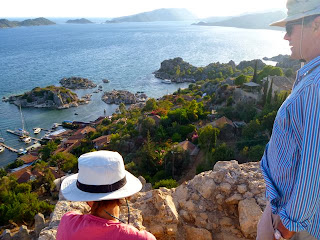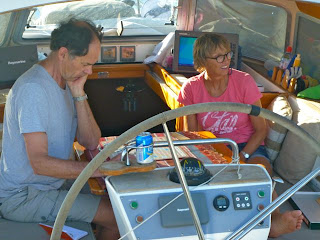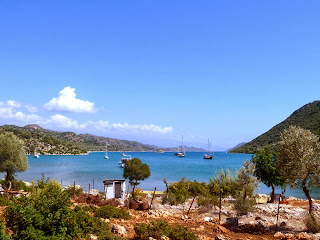In other parts of the nautical world, people are sick with anxiety. Emails from home have become incoherent. Our high-level contacts in the America's Cup Kiwi support team are sleep-deprived and totally stressed out. We sympathise, and hope Dean Barker will put them out of their misery long before this post is fully digested. Then our dear friends can get back on the water themselves.
 |
| Even the calmest of anchorages is ruffled by 30 knots |
No scoreboard is being kept where we are, though a surprising number of on-the-water days have been cancelled due to high winds. Nothing that a hire car and last-minute hotel bookings can't take care of. We are, if nothing else, adaptable.
 |
| Minyon hotel in Kaleici, the old part of Antalya |
 |
| You can see Antalya on a fine day from Termessos theatre |
We thought we'd seen the best ruins that Turkey has to offer. We've seen a fair few, as you who follow this blog regularly will know (groan). There is a moment when you think you don't need to scramble over another lot of rubble under a relentless sun. Surely there are only so many variations of the theatre and the necropolis, the cistern and the bath-house? Then those canny Greeks and/or Romans reel you in with a beautiful harbour, or a mountain citadel, and confronted with their ingenuity and sophistication, their architectural daring and exquisite attention to detail your only response is an inarticulate "Wow!", or in Alex's case, something more colourful.
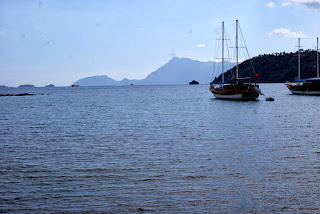 |
| South harbour at Phaselis |
 |
| Roman aqueduct at Phaselis |
 |
| Agora at Perge |
After four days snooping around archeological sites near Antalya (Turkey's major Mediterranean resort city), our "best ancient theatre" category is bursting with strong contenders. Ditto our "most atmospheric ancient city "and our "best ancient agora" categories. Alex was floored by the scale and complexity of Perge, a little east of Antalya. Neither of us had ever heard of Perge, but in its heyday (it had several, both pre- and post-Alexander the Great's blazing a trail through the region in 333 BC) it was a formidable power. Look at the size of this derelict stadium, and imagine it full of togas and chariots, if you can.
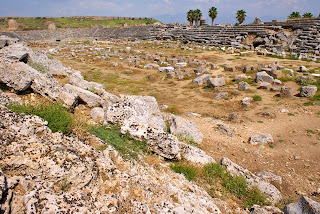 |
| Stadium at Perge |
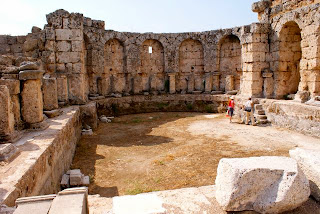 |
| One of several bathhouses at Perge |
 |
| The city gates at Perge |
 |
| Statue of Alexander the Great, from Perge theatre |
 |
| Perge bust |
 |
| Detail from a sarcophargus from Perge |
Antalya's museum has a staggering collection of marbles from Perge, not to mention pre-historic and Bronze Age relics. Antalya's harbour, a tight squeeze for modern yachts (we wouldn't contemplate going in), has been in use since Roman times. The old city centre of Kaleici runs down to the harbour, and is littered with fragments of old walls, stumps of ancient towers. The Emperor Hadrian, who certainly got around, left one of his commemorative gates in Antalya, as he did at Phaselis, the beautiful old port just south of Antalya, on the road to Finike.
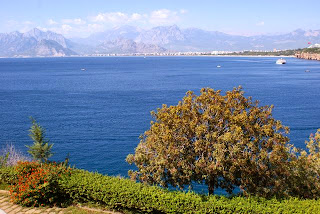 |
| Antalya bay, looking west |
 |
| Icecream! |
 |
| Kaleici house, Antalya |
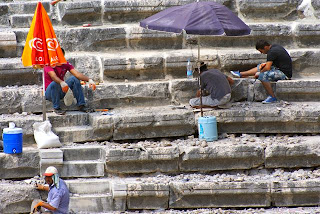 |
| Restoration of seating at Aspendos theatre |
From Aspendos (from whence the gladiator above, found in the best preserved Roman theatre in Turkey), we drove along a lush river valley to Beskonak, which now thrives on rafting tourism. We were heading to the ancient city of Selge, far above the river. Freya Stark visited Selge on her epic journey following in Alexander's path. Selge was much harder to get to back in 1957. Freya had to wait around in Antalya for several days until a jeep could be located to take her to where the road starts to climb at the end of the valley. She says she passed occasional travellers, "riding ponies with a red cloth under a carpet saddle". She also saw camps of nomads in the glades. No-one else. We saw dozens of blow-up rafts, packed with punters in yellow crash helmets, sliding along the deep blue river like woozy cars on a highway.
 |
| Rafting down the Kopru Canyon |
 |
| Roman bridge above the canyon |
 |
| The road up to Selge |
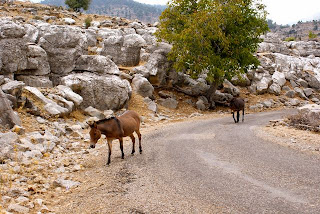 |
| Selge mules |
At the end of the valley, Freya transferred to a mule and, with the help of two guides, picked her way up the gorge, which is almost vertical in places, to the village which occupies the site of ancient Selge. It took her three hours. Sixty years later there are earth-moving machines widening the road up the valley and a one-lane sealed road winding for 11 km to the village itself from the Oluk bridge, which the Romans built to span the Kopru Canyon. The village has probably grown with the building of the road, but it is still small and, by Turkish city standards, primitive. My sense is that we saw much what Freya saw however. The theatre, she wrote, "was shallow as a saucer and the ploughed fields filled it". Its entrance is now blocked from the village by a pile of massive masonry. The peasant women and children who led us into the theatre told us that an earthquake had toppled the wall in 1984. They let their cows graze in there.
 |
| The ancient theatre sits above the village of Altinkaya |
 |
| Villagers show us the way into the theatre |
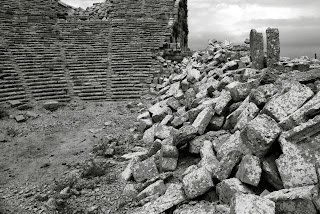 |
Selge theatre
|
 |
| One buyer, many sellers |
And then there was the Karain cave, perched above the plain opposite Termessos, the most dramatic ancient site of them all. I'm not so keen on caves, but we were in the area and the Karain Cave is the site of the oldest settlement in Turkey. The path up to the mouth of the cave is rough and steep and further than you think. "Is it worth it?" a young couple asked us when we arrived back in the carpark. The girl was wearing a headscarf, a full-length white robe (slim cut) and dress shoes. No, I wanted to say, you'll sweat like a pig and possibly break your ankle. "It depends what's in your head," is what I told her.
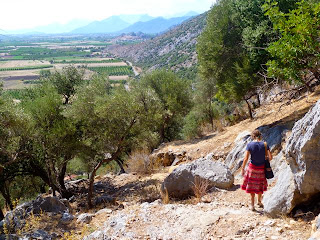 |
| The path to the Karain cave, and the valley below |
The cave has many chambers, lit by a brute sort of lamp. I touched the surface of the Gaudi-esque rock pillars which separate the chambers and it was like a strange new taste - I didn't recognise the sensation on my fingertips. How could rock feel like toughened old skin? People who lived here would have had hands just like mine. Were they afraid of the dark? Crude steps cut by the archeologists into the dimpled mud took us deeper into the mountainside. The people who lived here were very safe. They were probably not comfortable though. How many people would have sheltered here at a time? There is room for hundreds.
Archeologists can say for certain that people lived in the Karain cave continuously for 25,000 years. They display the evidence in the Antalya museum - stone-age adzes and scrapers and sprocket tools and the bones of very large animals - they say that rhinocerous and lions and hippos once roamed across Turkey's plains. They've also found tools in layers of the cave which they date to between 500,000 and 450,0000 BC. We tried to imagine this far back, but it's too much. If only the word awesome were not exhausted of meaning I would use it now. Awe for the enduring capacity of human beings to survive as long as we have.
 |
| Clambering at Termessos |
Awe too for the people of Termessos who built their city high in the mountains, with sheer rock cliff at back and sides, and defied anyone, even the great Alexander, to dare invade. An earthquake got them in the end. The city is unexcavated so whatever is still standing has been standing for a couple of thousand years without aid. Look at this theatre, will you? It takes first prize in our "best ancient theatre" category, as the judging stands.
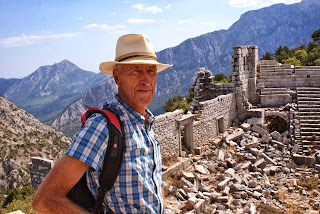 |
| The man behind the camera |



























